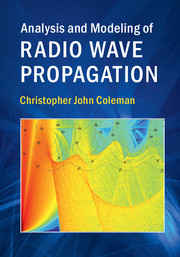Book contents
- Frontmatter
- Contents
- Preface
- 1 Basic Concepts
- 2 The Fundamentals of Electromagnetic Waves
- 3 The Reciprocity, Compensation and Extinction Theorems
- 4 The Effect of Obstructions on Radio Wave Propagation
- 5 Geometric Optics
- 6 Propagation through Irregular Media
- 7 The Approximate Solution of Maxwell's Equations
- 8 Propagation in the Ionospheric Duct
- 9 Propagation in the Lower Atmosphere
- 10 Transionospheric Propagation and Scintillation
- Appendix A Some Useful Mathematics
- Appendix B Numerical Methods
- Appendix C Variational Calculus
- Appendix D The Fourier Transform
- Appendix E Finding Stationary Values
- Appendix F Stratified Media
- Appendix G Useful Information
- Appendix H A Perfectly Matched Layer
- Appendix I Equations for TE and TM Fields
- Appendix J Canonical Solutions
- Index
10 - Transionospheric Propagation and Scintillation
Published online by Cambridge University Press: 19 January 2017
- Frontmatter
- Contents
- Preface
- 1 Basic Concepts
- 2 The Fundamentals of Electromagnetic Waves
- 3 The Reciprocity, Compensation and Extinction Theorems
- 4 The Effect of Obstructions on Radio Wave Propagation
- 5 Geometric Optics
- 6 Propagation through Irregular Media
- 7 The Approximate Solution of Maxwell's Equations
- 8 Propagation in the Ionospheric Duct
- 9 Propagation in the Lower Atmosphere
- 10 Transionospheric Propagation and Scintillation
- Appendix A Some Useful Mathematics
- Appendix B Numerical Methods
- Appendix C Variational Calculus
- Appendix D The Fourier Transform
- Appendix E Finding Stationary Values
- Appendix F Stratified Media
- Appendix G Useful Information
- Appendix H A Perfectly Matched Layer
- Appendix I Equations for TE and TM Fields
- Appendix J Canonical Solutions
- Index
Summary
We have seen that the ionosphere can provide a duct for radio waves, but most radio waves above a frequency of about 50 MHz will penetrate the ionosphere and escape. Consequently, it is these higher frequencies that are used for satellite communications, radio astronomy and satellite navigation. Although, as frequency rises, the effect of the ionosphere decreases, it can nevertheless have a significant impact on the operation of Earth–space systems. In particular, irregularity in the ionosphere can cause fluctuations in signals (scintillation) that can severely degrade the operations of such systems. The present chapter looks at techniques for analyzing and modeling the impact of the ionosphere on Earth–space systems.
Propagation through a Benign Ionosphere
When the frequency rises above 50 MHz, most radio waves will penetrate the ionosphere. Figure 10.1 shows what happens to a radio wave that is launched at an angle of 30◦ on frequencies from 20 to 50 Mhz. It can be seen that by a frequency of 50 MHz there is very little deviation of the ray path from the free space limit. This is important for areas such as radio astronomy where direction needs to be measured accurately. Nevertheless, for satellite navigation and radio astronomy at low frequencies, the effect of the ionosphere still needs to be taken into account. The variational techniques of Chapter 5 are ideal for such studies, the propagation path being that which makes the phase delay stationary (Fermat's principle). For transionospheric propagation, the stationary value of the phase path occurs at a minimum, and so one can use many of the excellent optimization techniques that have been developed in recent years (Press et al., 1992) to solve the discretized form of Fermat's principle. Figure 10.2 shows the propagation between the ground and a low Earth orbiting (LEO) satellite that has been calculated using these techniques (the paths of both ordinary and extraordinary modes are shown). The ionosphere is from around the equatorial regions and the wave frequency is 52 MHz. It will be noted that the ionosphere can still have a substantial effect on the propagation paths and for this reason, most satellite operations occur at frequencies well above 100 MHz.
- Type
- Chapter
- Information
- Analysis and Modeling of Radio Wave Propagation , pp. 222 - 235Publisher: Cambridge University PressPrint publication year: 2017



